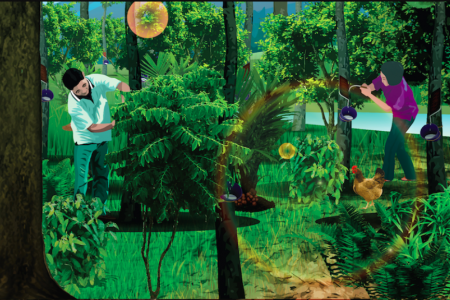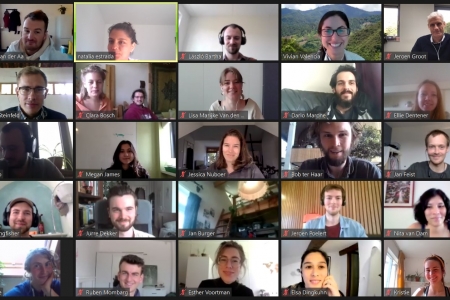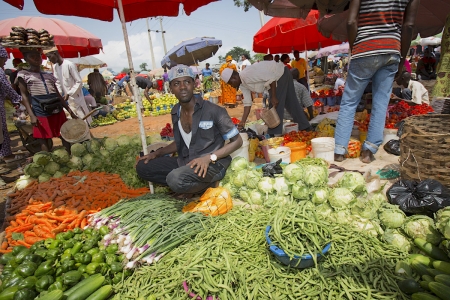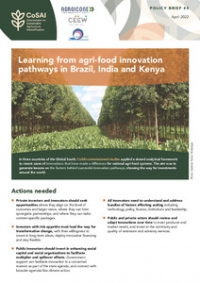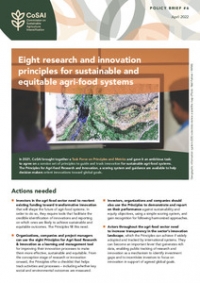This post is part of the Science on the Pulse series - a series which highlights the latest literature on ecosystem services and resilience.
We asked the Ecosystem Services and Resilience Working Group from the CGIAR Research Program on Water, Land and Ecosystems (WLE) what they thought were the best articles on ecosystem services and resilience last year. This is what they said! (Articles presented alphabetically by author)
1. A sustainability framework for assessing trade-offs in ecosystem services. Cavender-Bares, J. et al., 2015.
“Sustainability” is a word that is very popular in national and global development circles, but difficult to measure in a robust, consistent manner making it hard to know whether or not sustainability has been achieved or even incorporated into science policy-based decision making. Cavender-Bares and team made an important contribution towards making sustainability quantifiable by providing a very clear and logical sustainability framework applicable to ecosystem services. The framework applies concepts from welfare economics to ecological science and proposes optimal sustainable solutions are identified by considering the linkages between the natural capital, provision of ecosystem services and human well-being. The framework addresses thresholds and nonlinear dynamics by incorporating biophysical constraints and human values across different spatial and temporal levels. Highly recommended reading for policy makers and researchers alike!
2. Nature’s bounties: reliance on pollinators for health. Daily, G.C. & Karp, D.S., 2015.
Daily and Karp provide a punchy review of Smith et al.’s (2015) published work in The Lancet modelling future declines in pollinators to human health outcomes. This is one of the first studies trying to link change in an ecosystem service all the way to a human impact, rather than stopping at an intermediate economic or biophysical value meant to represent a measure of human well-being. In it, Smith et al. estimate the impact of a loss of 50, 75 and 100% of pollinators from global landscapes on micronutrient production from pollinator dependent crop (i.e our major source of dietary vitamins). They use data on local diets and consumption to estimate the likely impact of replacing these lost foods with staple crop calories on rates of micronutrient deficiency, non-communicable and malnutrition-related disease and disability adjusted life years (DALY). What allowed them to make this link was the finding that most pollinator-dependent crops contributing to human health are produced and consumed locally rather than imported, i.e. identifying a direct link between ecosystem service and beneficiary.
3. Remote sensing of ecosystem services: A systematic review. De Araujo Barbosa, C.C., Atkinson, P.M. & Dearing, J. a., 2015.
Overwhelmed by the vast quantities of data, tools and models to choose between to assess ecosystem services? Stop, breath and get a cup of coffee, then sit down and read Araujo Barbosa and team’s article. The team conducted an intensive search of scientific literature to assess the state of the art for using remote sensing to assess and value ecosystem services. This article is likely to get you bursting with new ideas about how to improve ecosystem service knowledge for your study site!
4. Assessing ecosystem services for informing land-use decisions: a problem-orientated approach. Forster et al. 2015.
If you want to conduct ecosystem service assessments that lead to changes on the ground, this paper is for you! The paper responds to the realisation that as ecosystem service assessments increase in abundance around the globe, decisions based on these assessments are still rare. It provides a clear and grounded guide to conducting ecosystem service assessments to solve real world problems, by reviewing and synthesising existing theories for mainstreaming ecosystem service assessments into a handy one-page schematic.
5. Fairly efficient, efficiently fair: Lessons from designing and testing payment schemes for ecosystem services in Asia. Leimona, B. Meine van Noordwijk, Rudolf de Groot and Rik Leemans. 2015.
Planning to implement or assess a PES scheme? Then, you should definitely read Leimona and team article. This article covers the history of the Payment for Ecosystem Services and identify key modifications to the traditional scheme in order to account for the multidimensionality of poverty and for the context of developing countries. The authors provide evidence from their empirical observation of PES in Asia that you will find valuable in any context.
6. Systems integration for global sustainability. Liu et al. 2015.
Liu and team convincingly argue for improved interdisciplinary integration to facilitate thorough systems research. They propose that achieving global sustainability requires studying changes in institutional, spatial and temporal levels across human and natural systems in an integrated manner, and that it’s only by doing this that we can expect true progress towards finding and making practical advances towards sustainability. Compartmentalised approaches will not provide the breakthroughs that we are hoping for. We wonder if it’s time to define a new category of geographers (as the traditional cross-discplinarians) alongside human and physical to tackle this need for interdiscplinary action head-on...welcome the “socio-ecological geographers”!
7. Plant functional traits in agroecosystems: a blueprint for research. Martin, A.R. and Isaac, M.E. 2015.
Technology is adapting faster to human needs than food production. Compare for example your first cell-phone with your latest one, you will find a large difference particularly in the multi-functionality. However, since the green revolution agriculture has been measured with only one metric, yield, despite the negative impacts at planetary scale of this simplified view of agriculture. Martin and Isaac, in their provocative article highlights the importance of considering agriculture and crops as providers of diverse ecosystem services by selecting crops based on their functional traits. Functional traits is an advanced concept commonly applied in ecology, but that urgently needs to be incorporated into agronomy as the authors call. We invite you to read Martin and Isaac article to challenge how you see and think about agriculture and start contributing to the multi-functional agriculture that we need!
8. Historical dynamics in ecosystem service bundles. Renard, D., Rhemtulla, J.M, and E. Bennett. 2015.
We really liked this paper by Renard et al. because it is one of the first to examine trade-offs and synergies within ES bundles through time - a dimension that is rarely assessed due to the challenges of collating appropriate data. Renard et al. do an extraordinary job of bringing together data on nine ecosystem services from 1971 to 2006 across 131 municipalities in a mixed-use landscape in Quebec, Canada to explore spatio-temporal dynamics of ES bundles. There results show that ES and their bundles are much more variable in time and space that our typical snapshot approach to ES quantification assumes. While most ES increased over the 35 yr timespan by 20-40%, they do so at different rates and shifted spatially through time (only a few ES decreased) to result in more spatial variability by the final time period. Interestingly, they found that subsets of ES can become spatially prioritized across a landscape based on agricultural policy and global market trends - creating and maintaining ES heterogeneity. However, this study also raises questions about using snapshots of ES provision at a single point in time to build our understanding of ES relationships in complex and dynamic social-ecological systems, especially when this knowledge is used as the basis for managing multiple ecosystem services (ES) simultaneously, a key interest of the ESR and WLE group.
9. Have Ecosystem Services Been Oversold? Silvertown, Jonathan. 2015.
This paper provides a critical review of ecosystem services from conception to application and show how this paradigm may have constrained our thinking about conservation and alternative approaches. Ecosystem services have risen rapidly to fame in several research disciplines and this paper provides a useful critique of the pluses and minuses of this rise from a nature conservation perspective. They argue that it would be preferable for biodiversity conservation to use the ecosystem service concept to promote the moral or intrinsic value of nature and move away from monetisation, which risks creating false market values and supporting bad or hidden agendas that may not benefit biodiversity.
10. An integrated approach to understanding the linkages between ecosystem services and human well-being. Yang et al. 2015.
Yang and colleagues go beyond current measures of ecosystem service demand or use to get at the actual impacts of ecosystem services on livelihoods as measured through dependence on ecosystem services and changes in ecosystem services received. We particularly like that they propose an index system of human dependence on ecosystem services, which allows us to start getting at the variation in impact of ecosystem service change on different people, and that they advocate the use of net rather than gross ecosystem benefits to capture both services and disservices of ecosystems. Well worth a read!
Do you have comments on any of the articles that made it to the top 10? Share your thoughts, we’d love to hear them!






